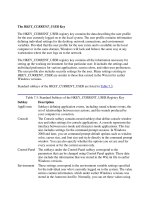Tài liệu The IS-LM model doc
Bạn đang xem bản rút gọn của tài liệu. Xem và tải ngay bản đầy đủ của tài liệu tại đây (777.92 KB, 11 trang )
1
Chapter Eleven
1
A PowerPoint
Tutorial
to Accompany macroeconomics, 5th ed.
N. Gregory Mankiw
Mannig J. Simidian
®
CHAPTER ELEVEN
Aggregate Demand II
Chapter Eleven
2
Now that we’ve assembled the IS-LM model of aggregate demand,
let’s apply it to three issues:
1) Causes of fluctuations in national income
2) How IS-LM fits into the model of aggregate supply and aggregate
demand
3) The Great Depression
2
Chapter Eleven
3
I
S
-
L
M
The intersection of the IS curve and the LM
curve determines the level of national income.
When one of these curves shifts, the short-run
equilibrium of the economy changes, and
national income fluctuates. Let’s examine how
changes in policy and shocks to the economy can
cause these curves to shift.
Chapter Eleven
4
3
Chapter Eleven
5
LM
r
Y
IS
A
+∆G
Consider an increase in government purchases.
This will raise the level of income by ∆G/(1- MPC)
IS´
B
The IS curve shifts to the right by ∆G/(1- MPC) which raises income
and the interest rate.
Chapter Eleven
6
4
Chapter Eleven
7
IS
r
Y
LM
A
LM′
B
+∆M
Consider an increase in the money supply.
The LM curve shifts downward and lowers the interest rate which raises
income. Why? Because when the Fed increases the supply of money, people
have more money than they want to hold at the prevailing interest rate. As a
result, they start depositing this extra money in banks or use it to buy bonds.
The interest rate r then falls until people are willing to hold all the extra
money that the Fed has created; this brings the money market to a new
equilibrium. The lower interest rate, in turn has ramifications for the goods
market. A lower interest rate stimulates planned investment, which increases
planned expenditure, production, and income Y.
Chapter Eleven
8
The IS-LM model shows that monetary policy influences income by
changing the interest rate. This conclusion sheds light on our analysis
of monetary policy in Chapter 9. In that chapter we showed that in
the short run, when prices are sticky, an expansion in the money
supply raises income. But, we didn’t discuss how a monetary
expansion induces greater spending on goods and services--a process
called the monetary transmission mechanism.
The IS-LM model shows that an increase in the money supply lowers
the interest rate, which stimulates investment and thereby expands the
demand for goods and services.
5
Chapter Eleven
9
Chapter Eleven
10
You probably noticed from the IS and LM diagrams that r and Y were on
the two axes. Now we’re going to bring a third variable, the price level
(P) into the analysis. We can accomplish this by linking both two-
dimensional graphs.
r
r
P
P
Y
Y
Y
Y
IS
IS
LM(P
LM(P
1
1
)
)
A
A
A
A
AD
AD
To derive AD, start at point A in the top
graph. Now increase the price level from P
1
to P
2
.
An increase in P lowers the value of real money
balances, and Y, shifting LM leftward to point B.
The +∆P triggers a sequence of events that end
with a -∆Y, the inverse relationship that defines
the downward slope of AD.
Notice that r increased. Since r increased, we know
that investment will decrease as it just got more
costly to take on various investment projects. This
sets off a multiplier process since -∆I causes a –∆Y.
The - ∆Y triggers -∆C as we move up the IS curve.
LM(P
LM(P
2
2
)
)
B
B
B
B
P
2
P
1









